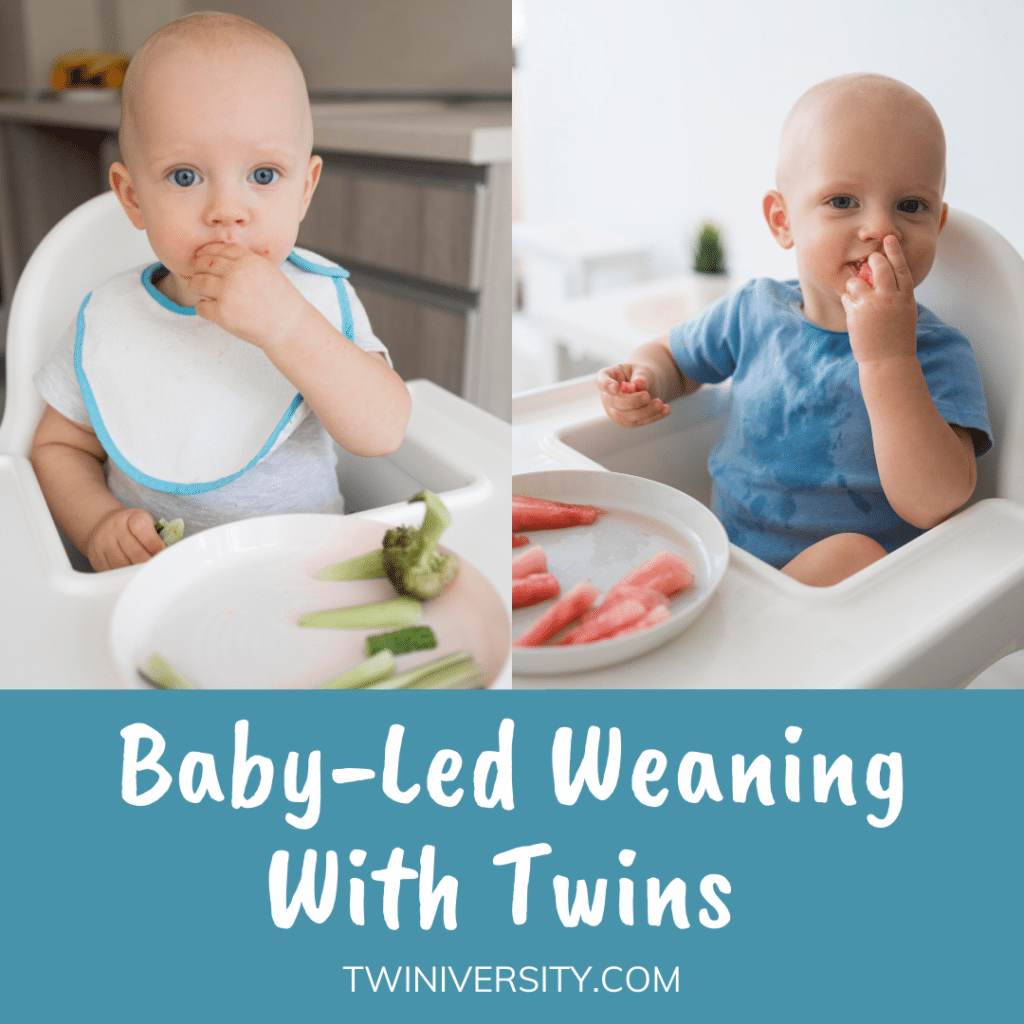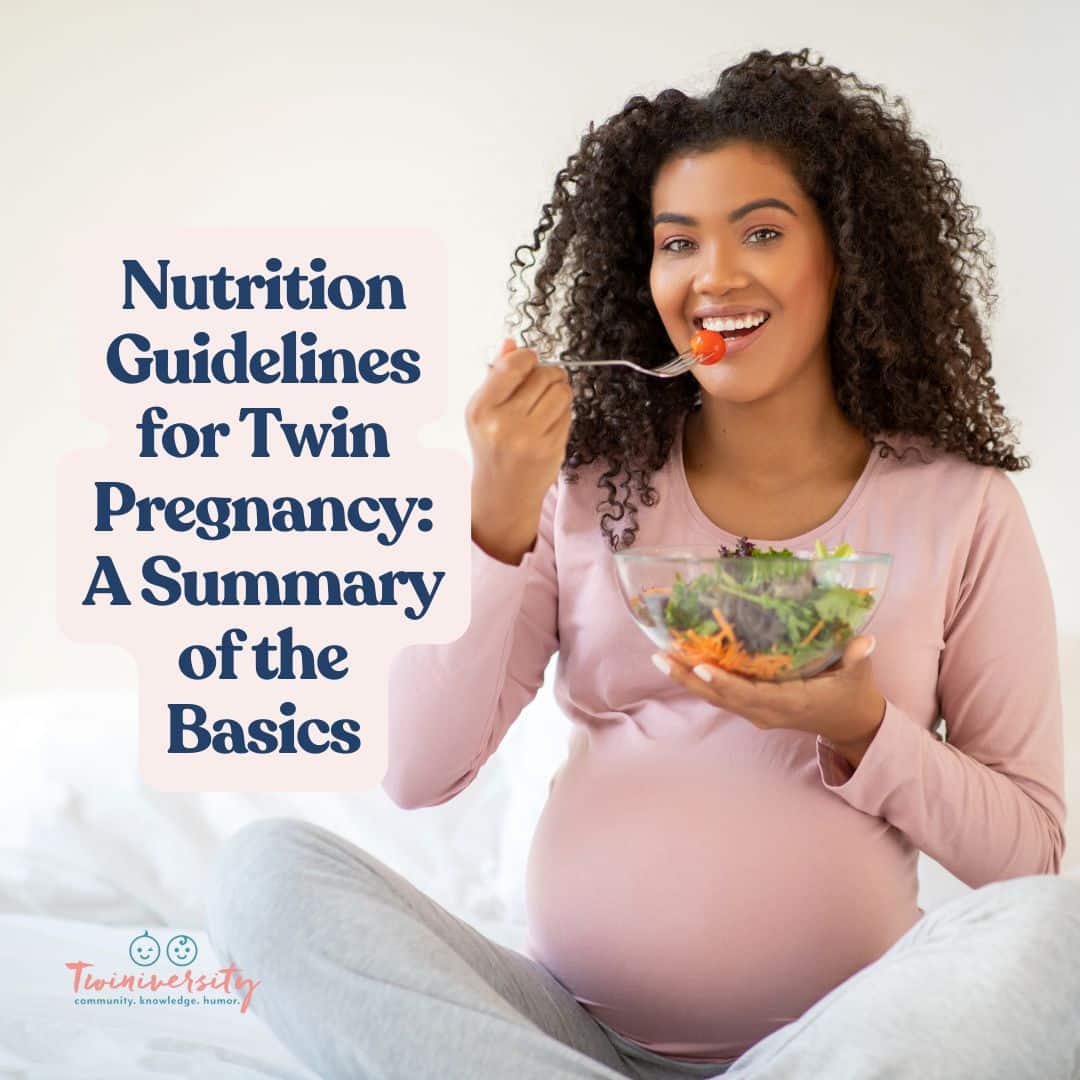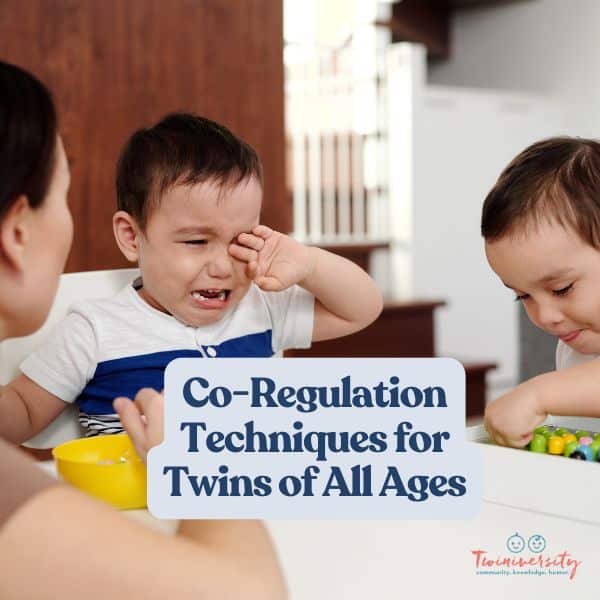Last updated on June 30th, 2024 at 07:16 am
The first few months of life with twins are full of milestones. From that first smile to the first time they crawl, your twins are constantly learning new things. At around six months old you might be thinking about introducing solid foods. Wondering about the best way to feed your twins? You might consider baby-led weaning or BLW. Read on to learn more about how to practice baby-led weaning with twins.
Disclaimer: All content on this Web site, including medical opinion and any other health-related information, is for informational purposes only. It should not be considered to be a specific diagnosis or treatment plan for any individual situation. Use of this site and the information contained herein does not create a doctor-patient relationship. Always seek the direct advice of your own doctor in connection with any questions or issues you may have regarding your own health or the health of others.
What Is Baby-Led Weaning With Twins?
Coined by Dr. Gill Rapley, baby-led weaning (BLW) means feeding your baby whole food rather than pureed baby food. When baby is developmentally ready, parents and caregivers offer food and let the babies decide what and how much they want to eat. The baby then feeds it to themselves while parents keep a close eye on them.
Unlike traditional puree feeding, BLW puts the baby in charge of their mealtime, allowing them to learn the skills of feeding, chewing and swallowing from the get-go. With BLW babies are exposed to all sorts of tastes, smells, and textures and are able to establish their own preferences and palate from day one.
What Are the Benefits of Baby-Led Weaning With Twins?
You might have heard the phrase, “food before one is just for fun.” While this is true, there are a number of benefits to baby-led weaning with twins that go beyond exploring and having fun eating food.
Baby-Led Weaning Is Cost-Effective and Can Save You Money
It’s no secret that baby food can get expensive and, with twins, it can be almost impossible for some families to keep up. Consider what a jar of baby food costs vs. buying the whole food form and modifying it for baby-led weaning. Plus, you are likely already buying the food for your family and one or two more portions won’t mess with your grocery budget like adding 10-15 jars of baby food can.
Baby-Led Weaning Saves Time
Spoon feeding infant twins can take a long time. When you do baby-led weaning, you can offer the food your family is eating in modified form and eat together, rather than taking the time serve a separate meal to the baby. Another benefit is the ability to be hands-free while your twins eat. While it’s best to eat with them, parents can also choose to use the time to get things done, while keeping a close eye on babies.
Baby-Led Weaning Strengthens Social and Developmental Skills
Babies learn best through observing their caregiver’s behavior. With BLW, the entire family can sit down and enjoy a meal together allowing babies to observe and learn how to eat. Babies also get an awareness of table manners and learn how to enjoy family mealtimes, an important part of healthy child development.
With BLW, babies are strengthening other developmental skills as well. The process of picking up food and bringing it to their mouth helps develop their pincer grasp, dexterity and hand-eye coordination.
Baby-Led Weaning Encourages Healthy Eating Habits
When a baby is in control of eating, they learn how to moderate their food intake so they don’t overstuff their mouths or bellies. It teaches them to pay attention to their own hunger cues and regulate their energy intake based on their own needs without limits like the end of a jar, or us wanting them to have one more bite. When you offer whole foods baby also learns how to make healthy food choices from day one while developing a taste for these foods.
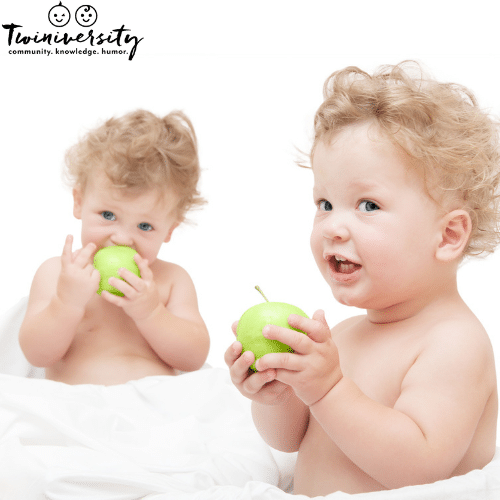
Is Baby-Led Weaning With Twins Safe?
Like all parenting choices, BLW is not without its’ controversy. Some people believe that babies are not able to digest real food properly or that they won’t get enough nutrients. In reality, babies older than six months are fine to eat and digest real food as long as it follows a healthy diet and meets their nutritional requirements.
Another safety concern of BLW is the risk of choking. However, according to a comprehensive review of studies, the only real risk of choking occurs when a food (including cereals and purees) is offered too early or when babies are given foods that are difficult to gum and break down before swallowing (raw apple, coin-sized chunks of meat). If you are following BLW correctly, the risk of choking is minimal.
This is because babies are born with an incredibly efficient gag reflex that actually helps prevent choking. While scary, gagging is not the same thing as choking. Instead, it is a harmless and necessary tool to help learn how to properly chew, swallow and bring food back up if needed. Learning how to tell the difference between gagging and choking is an essential step to successful (and relatively anxiety-free) BLW.
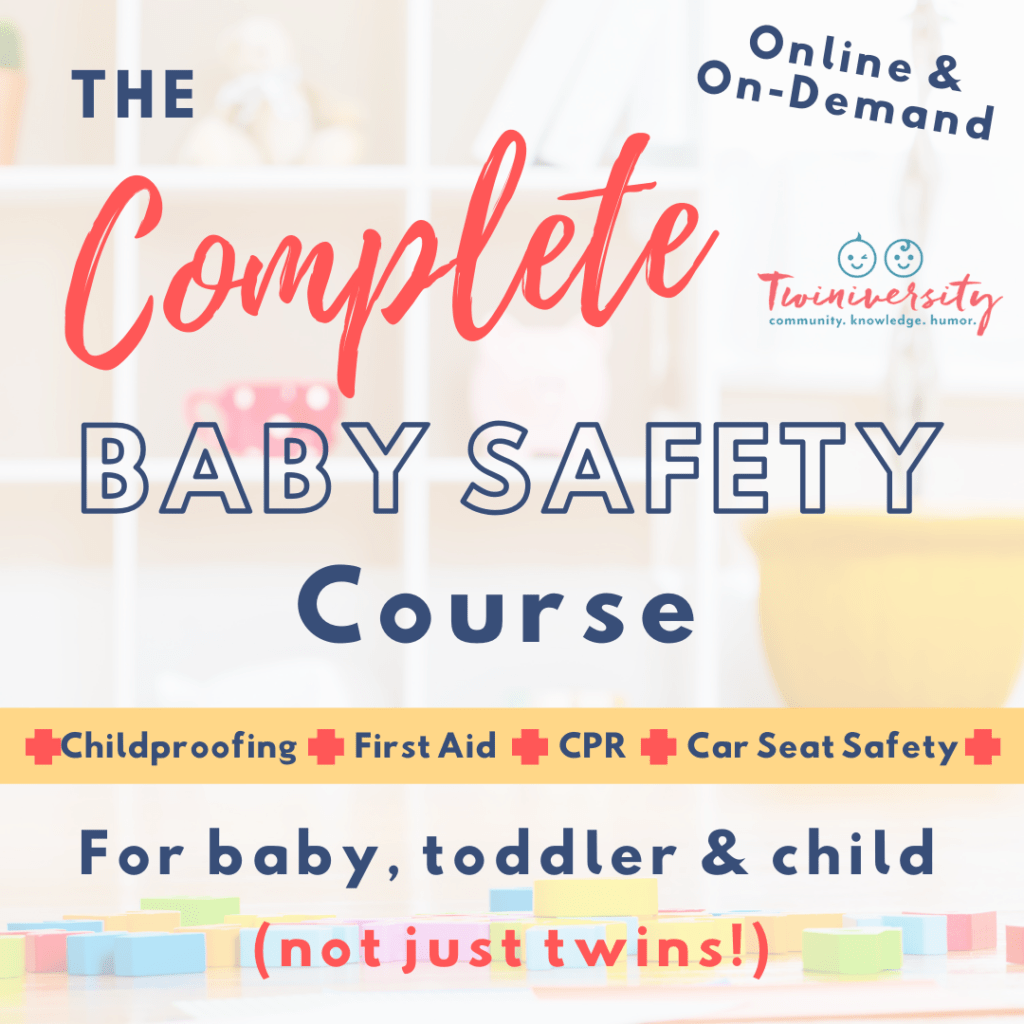
Need some baby safety training? Take the Twiniversity Complete Baby Safety course, offered on-demand. Includes video modules on infant, toddler, and child CPR, first aid, and common medical ailments, plus car seat installation and safety and childproofing your home. Click here to learn more!
How Do I Start Baby-Led Weaning With Twins?
It’s important to note that BLW is not about stopping breastfeeding or formula. These should still be the primary source of nutrition for babies under the age of one.
Before starting baby-led weaning, babies must meet certain criteria:
- at least six months old
- able to sit unassisted
- have good head control
- showing interest in food
- able to pick up an object and bring it to their mouths
One thing not required is teeth. Those strong baby gums are able to mash food adequately so don’t worry if your little ones are still toothless.
When you and your babies are ready, set them up in a sturdy high chair, ideally one that has foot support, and start by offering one new food every 3 days. Let them choose what and how much they eat. Don’t force-feed them or put the food in their mouths, but do sit with them and model eating. Remember that the goal is not for them to eat what you’ve served, but to learn how to eat safely and enjoy the experience.
Be sure to monitor for any reactions to a new food such as hives or redness and let your pediatrician know.
Fair warning: one drawback of BLW is that it can be very messy. With two babies your kitchen can end up looking like a high school cafeteria after a food fight. If you struggle with the mess, put a plastic drop cloth under the high chairs, a towel under their bums, and use a silicone sticky mat on the highchair tray to help make cleanup easier.
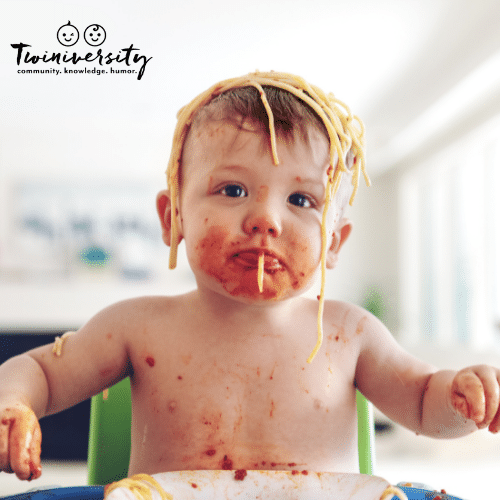
What First Foods Can I Feed My Twins?
You can start with almost any food you like. Exceptions include honey and cow’s milk before age one. At first, offer single ingredient soft foods cut into spears or strips. Aim for a size that is thin and long enough for the baby to grasp and hold. Once they have mastered holding and chewing the food you can offer more variety and smaller sizes to work on that pincer grasp.
Some common first foods include:
- steamed vegetables cut into spears such as sweet potato, carrots, squash, and broccoli florets
- soft fruit such as steamed apple strips, banana, pear, and avocado
- ground or shredded meat
- lightly toasted bread cut into strips
- whole milk yogurt
After they get the hang of eating the basics, you can simply serve them what the family is eating. If your meals are often too spicy, salty, or messy for them try a deconstruct version or make separate portions for baby.
There are some foods that you want to avoid when doing baby-led weaning. These include:
- Food that is hard or crunchy such as raw apple and carrots (unless shredded), nuts, chips and popcorn
- Anything sticky or chewy such as spoonfuls of peanut butter or marshmallow
- Round or coin-shaped food such as grapes, cherry tomatoes and hot dogs
- Chunks of chewy food such as cheese and bread
- High mercury fish including swordfish, roughy, and shark
Studies show that early introduction to high-allergen foods such as peanut butter and eggs can decrease the likelihood of developing an allergy. Be sure to know the signs of an allergic reaction and speak to your pediatrician if you have a concern or a family history of certain allergens.
Start out slow and simple but once baby gets the hang of it be sure to add variety to get the most benefit out of BLW and the most nutritional value. Including enough iron, calcium and fiber is super important to baby’s growing body. Broadening their exposure to different tastes and textures can also help cut down on picky eating in the toddler years.
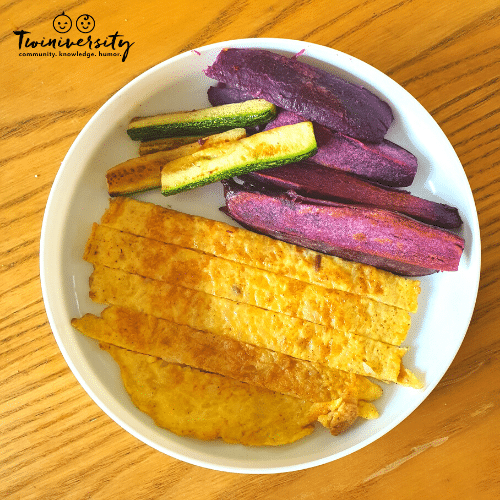
Can I Use Purees While Baby-Led Weaning With Twins?
Purees are still a great source of vitamins and nutrients and you may want to supplement your baby’s diet with them. It is totally fine to use pureed food as part of BLW but it is recommended that you have the baby feed themself with a spoon that you have pre-loaded with the puree. This is also the best way to introduce other spoon-fed food such as yogurt, oatmeal, and soup.
You may also need to use purees if you have a daycare provider who is not comfortable with baby-led weaning. Don’t stress over this, just continue using BLW at home and send purees to daycare.
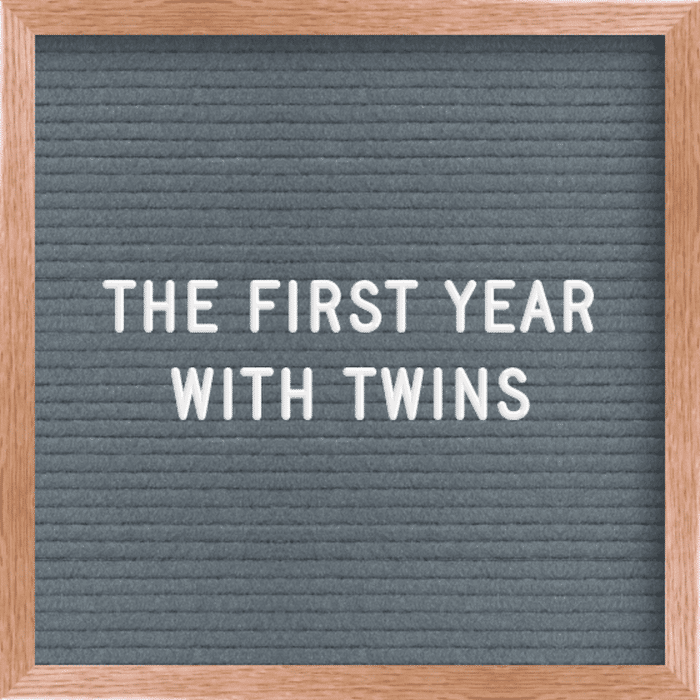
Stressing out with your infant twins? Let us help! Learn what to expect in the first year with twins, including tips, tricks, and advice from real twin parents who have been there. Click here to learn more… and while you’re at it, check out our twin parent coaching services and Twiniversity shop!
Baby-Led Weaning Menu Ideas
Your first month will be all about learning the basics of BLW, for both you and baby, though most babies will quickly get the hang of it quickly. While BLW encourages you to feed baby whatever you’re eating, you can and should Pinterest all the BLW recipes to add nutrition and variety for baby. You might even find ways to boost your own healthy eating habits.
Some days the babies will eat what you’re having, others they get their own meal. Have fun experimenting and trying new things together. Need some ideas? Here’s a sample 3-day baby-led weaning menu for 9-month old twins:
DAY 1
- Breakfast: toast fingers with avocado or nut butter spread, blueberries
- Lunch: steamed peas and carrots, peaches, cheese, crockpot shredded chicken (find recipe here)
- Dinner: pasta with veggie bolognese sauce (find recipe here) and parmesan cheese, steamed asparagus
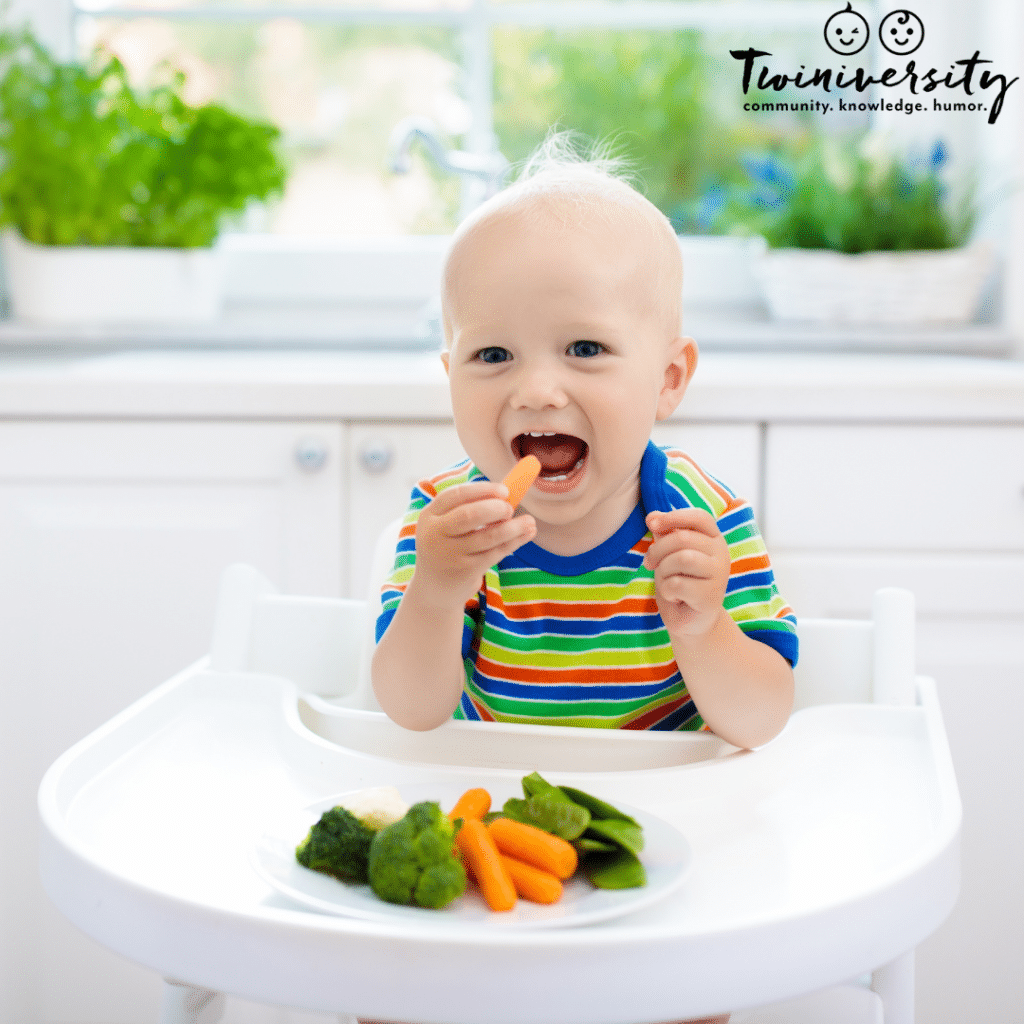
DAY 2
- Breakfast: banana avocado muffins (find recipe here), yogurt with fresh raspberries
- Lunch: sweet potato fries (find recipe here), green beans, fresh turkey, cheese, crackers
- Dinner: broccoli cheddar patties (find recipe here), brown rice, pears
DAY 3
- Breakfast: blueberry pancakes, banana, cottage cheese
- Lunch: squash grilled cheese (find recipe here), peaches, peas
- Dinner: deconstructed tacos (ground meat, whole wheat tortillas cut into strips, avocado, shredded cheese, lettuce and tomatoes, oranges
Start Healthy Eating Habits Early
Baby-led weaning with twins is a great way to build healthy eating habits, encourage independence and allow the whole family to enjoy mealtimes together. Just remember, always wait until your babies are developmentally ready and follow the safety and nutritional guidelines. You and your twinnies will be enjoying meals together in no time!

